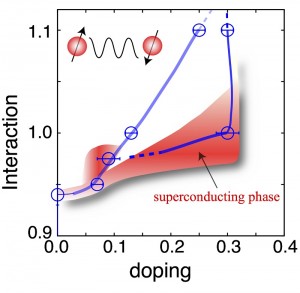Novel mechanism of superconductivity clarified by K computer Charge fluctuation induces superconductivity

Since the discovery of the iron-based superconductors in 2008 by Professor Hideo Hosono’s group at Tokyo Institute of Technology, many families of iron-based superconductors have been found. Because some iron-based superconductors are “high-critical-temperature (high-Tc) superconductors”, whose critical temperatures (the temperature at which they become superconducting) are higher than -220 degrees Celsius, it is expected that clarification of the mechanism of superconductivity will offer a guideline for synthesizing new higher-Tc materials. As a result, these materials have been the focus of intensive study around the world. In spite of this huge amount of research, the mechanism of superconductivity has yet to be fully clarified. One of the difficulties in revealing the mechanism has been the lack of efficient theoretical methods for analyzing the complex theoretical model of iron-based superconductors.

© 2015 Takahiro Misawa and Masatoshi Imada.
Phase diagram of theoretical model for iron-based superconductos.
Assistant Professor Takahiro Misawa and Professor Masatoshi Imada, in the University of Tokyo Graduate School of Engineering Department of Applied Physics, have overcome this difficulty by utilizing the K computer. By analyzing a theoretical model derived from first principles calculations, the researchers found that increase in electron density fluctuation, which had been thought to be of limited importance, induces superconductivity.
Working only from experimental information of lattice structures and elements for iron-based superconductors, the researchers succeeded in numerically reproducing a superconducting state from the principles of quantum mechanics and statistical physics. This calculation is the world’s first success in generating a superconducting state from first principles. Furthermore, they identified the origin of superconductivity by systematically controlling the electron-electron Coulomb interaction. Such an ideal control is difficult in experiments. As a result, the researchers showed that superconductivity always appears when electron-density fluctuation is enhanced.
This result has significant implications for the study of high-temperature superconductivity. It is expected that the mechanism revealed in this study will act as a guide to inspire the search for higher-Tc materials.
Paper
Takahiro Misawa and Masatoshi Imada,
“Superconductivity and its mechanism in an ab initio model for electron-doped LaFeAsO”,
Nature Communications Online Edition: 2014/12/22 (Japan time), doi: 10.1038/ncomm6738.
Article link(Publication)
Links
Graduate School of Engineering
Department of Applied Physics, Graduate School of Engineering
Imada Group, Department of Applied Physics, Graduate School of Engineering






